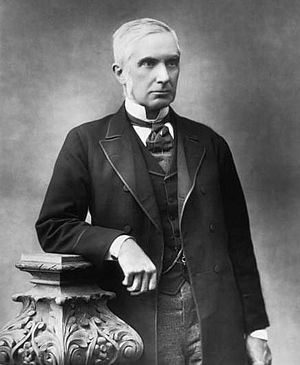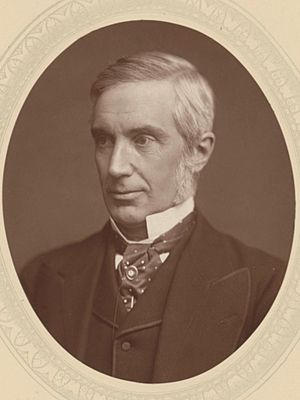Edward Fry facts for kids
Quick facts for kids
Sir Edward Fry
|
|
|---|---|
 |
|
| Lord Justice of Appeal | |
| In office 1883–1892 |
|
| Justice of the High Court | |
| In office 1877–1883 |
|
| Personal details | |
| Born | 4 November 1827 |
| Died | 19 October 1918 (aged 90) |
Sir Edward Fry (born November 4, 1827 – died October 19, 1918) was an important English judge. He was a Lord Justice of Appeal from 1883 to 1892. He also helped solve international disagreements as an arbitrator at the Permanent Court of Arbitration.
About Edward Fry
Edward Fry came from a well-known family in Bristol, England. His family were Quakers. They owned the famous chocolate company, J. S. Fry & Sons. His grandfather was Joseph Storrs Fry. His brothers included Joseph Storrs Fry II, who ran the chocolate business, and Lewis Fry, who became a politician.
Edward Fry became a lawyer in 1854. He was made a Queen's Counsel in 1869. This is a special title for experienced lawyers. In 1877, he became a judge in the Chancery court. He was also given the title of 'Sir' (knighted).
In 1883, he became a judge in the Court of Appeal. He retired from the court in 1892. Even after retiring, he continued to work on legal cases. He helped with some cases in the Judicial Committee of the Privy Council. This is a high court that hears appeals from other courts.
In 1897, he led a special group called a royal commission. This group looked into laws about land in Ireland. He also worked as an arbitrator to settle big arguments. He helped solve a coal miners' strike in Wales in 1898. He also helped with a fishing dispute in Grimsby in 1901. Later, he settled disagreements between a railway company and its workers in 1906 and 1907.
Edward Fry received two high honors in 1907: the GCMG and GCB.
International Legal Work
Sir Edward Fry was also involved in international law. In 1902, he was one of five arbitrators at The Hague. They settled a dispute between the United States and Mexico. This was the first time the Permanent Court of Arbitration helped countries solve a problem.
In 1904, he was a British legal expert on a special group. This group investigated the Dogger Bank incident. This happened when the Russian navy accidentally attacked British fishing boats. He also took part in the second Hague Conference in 1907.
From 1908 to 1909, he was an arbitrator between France and Germany. This case was about France taking soldiers who had left the German army. Some of these soldiers were German citizens.
Interests in Nature
Besides his legal work, Edward Fry had other interests. He was on the council of University College London. He was also very interested in Zoology, the study of animals. He became a member of the Royal Society in 1883. This is a famous group for scientists.
He wrote two books about bryophytes. These are small plants like mosses and liverworts. His book British Mosses came out in 1892. With his daughter Agnes, he wrote The Liverworts: British and Foreign in 1911.
Family Life
Edward Fry married Mariabella Hodgkin in 1859. They had seven daughters and two sons. They lived in Highgate, a part of London. Their house, 5 The Grove, was later owned by the singer George Michael.
Their children included:
- Joan Mary Fry (1862–1955) – a social reformer who helped people.
- Roger Eliot Fry (1866–1934) – a famous artist and member of the Bloomsbury Group.
- Agnes Fry (1869–1957) – she helped her father write science books and later wrote about his life.
- Isabel Fry (1869-1958) – an educator.
- (Sara) Margery Fry (1874–1958) – she worked to improve prisons and was a leader at Somerville College.
- (Anna) Ruth Fry (1878–1962) – a pacifist and Quaker activist who worked for peace.
Images for kids



